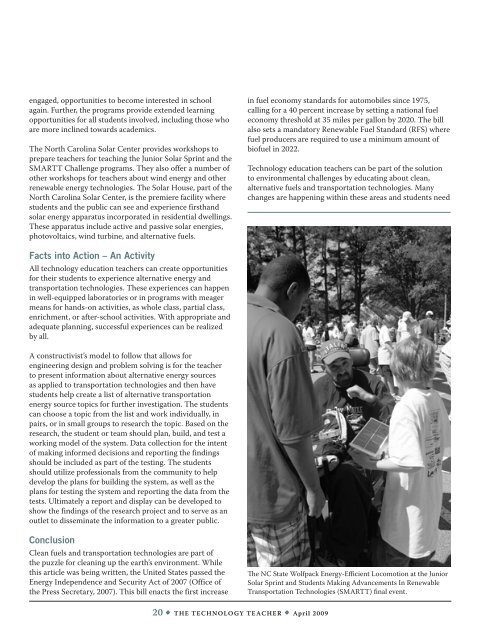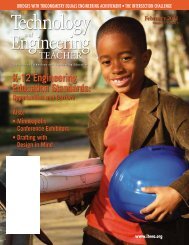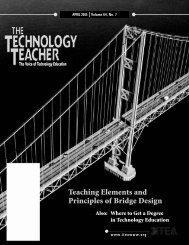Design Your Own Underwater ROV - International Technology and ...
Design Your Own Underwater ROV - International Technology and ...
Design Your Own Underwater ROV - International Technology and ...
You also want an ePaper? Increase the reach of your titles
YUMPU automatically turns print PDFs into web optimized ePapers that Google loves.
engaged, opportunities to become interested in school<br />
again. Further, the programs provide extended learning<br />
opportunities for all students involved, including those who<br />
are more inclined towards academics.<br />
The North Carolina Solar Center provides workshops to<br />
prepare teachers for teaching the Junior Solar Sprint <strong>and</strong> the<br />
SMARTT Challenge programs. They also offer a number of<br />
other workshops for teachers about wind energy <strong>and</strong> other<br />
renewable energy technologies. The Solar House, part of the<br />
North Carolina Solar Center, is the premiere facility where<br />
students <strong>and</strong> the public can see <strong>and</strong> experience firsth<strong>and</strong><br />
solar energy apparatus incorporated in residential dwellings.<br />
These apparatus include active <strong>and</strong> passive solar energies,<br />
photovoltaics, wind turbine, <strong>and</strong> alternative fuels.<br />
in fuel economy st<strong>and</strong>ards for automobiles since 1975,<br />
calling for a 40 percent increase by setting a national fuel<br />
economy threshold at 35 miles per gallon by 2020. The bill<br />
also sets a m<strong>and</strong>atory Renewable Fuel St<strong>and</strong>ard (RFS) where<br />
fuel producers are required to use a minimum amount of<br />
biofuel in 2022.<br />
<strong>Technology</strong> education teachers can be part of the solution<br />
to environmental challenges by educating about clean,<br />
alternative fuels <strong>and</strong> transportation technologies. Many<br />
changes are happening within these areas <strong>and</strong> students need<br />
Facts into Action – An Activity<br />
All technology education teachers can create opportunities<br />
for their students to experience alternative energy <strong>and</strong><br />
transportation technologies. These experiences can happen<br />
in well-equipped laboratories or in programs with meager<br />
means for h<strong>and</strong>s-on activities, as whole class, partial class,<br />
enrichment, or after-school activities. With appropriate <strong>and</strong><br />
adequate planning, successful experiences can be realized<br />
by all.<br />
A constructivist’s model to follow that allows for<br />
engineering design <strong>and</strong> problem solving is for the teacher<br />
to present information about alternative energy sources<br />
as applied to transportation technologies <strong>and</strong> then have<br />
students help create a list of alternative transportation<br />
energy source topics for further investigation. The students<br />
can choose a topic from the list <strong>and</strong> work individually, in<br />
pairs, or in small groups to research the topic. Based on the<br />
research, the student or team should plan, build, <strong>and</strong> test a<br />
working model of the system. Data collection for the intent<br />
of making informed decisions <strong>and</strong> reporting the findings<br />
should be included as part of the testing. The students<br />
should utilize professionals from the community to help<br />
develop the plans for building the system, as well as the<br />
plans for testing the system <strong>and</strong> reporting the data from the<br />
tests. Ultimately a report <strong>and</strong> display can be developed to<br />
show the findings of the research project <strong>and</strong> to serve as an<br />
outlet to disseminate the information to a greater public.<br />
Conclusion<br />
Clean fuels <strong>and</strong> transportation technologies are part of<br />
the puzzle for cleaning up the earth’s environment. While<br />
this article was being written, the United States passed the<br />
Energy Independence <strong>and</strong> Security Act of 2007 (Office of<br />
the Press Secretary, 2007). This bill enacts the first increase<br />
The NC State Wolfpack Energy-Efficient Locomotion at the Junior<br />
Solar Sprint <strong>and</strong> Students Making Advancements In Renewable<br />
Transportation Technologies (SMARTT) final event.<br />
20 • The <strong>Technology</strong> Teacher • April 2009
















